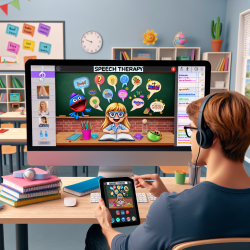Introduction
In the ever-evolving world of speech-language pathology, staying ahead of the curve is crucial. As practitioners, we strive to leverage cutting-edge research to improve therapy outcomes for children. A recent study titled "Fabrication of a three-dimensional micro/nanocarbon structure with sub-10 nm carbon fiber arrays based on the nanoforming and pyrolysis of polyacrylonitrile-based jet fibers" presents groundbreaking advancements that could potentially revolutionize our approach to therapy. Let's explore how these findings can be applied in our practice to enhance child development outcomes.
Understanding the Research
The study focuses on the fabrication of three-dimensional micro/nanocarbon structures using sub-10 nm carbon fiber arrays. This innovative technique involves the nanoforming and pyrolysis of polyacrylonitrile-based jet fibers, resulting in carbon fibers with exceptional properties. The researchers developed methods for initiating electrostatic jetting and forming submicron-to-nanoscale fibers, which are then converted into carbon fibers through a controlled pyrolysis process.
Implications for Speech Therapy
While the study primarily addresses advancements in materials science, its implications extend to speech therapy in several ways:
- Enhanced Sensory Feedback: The precise control over fiber size and structure could lead to the development of devices that provide enhanced sensory feedback during therapy sessions. This could improve a child's ability to perceive and produce speech sounds accurately.
- Customized Therapy Tools: The flexibility and strength of nano-carbon fibers could be harnessed to create customized therapy tools tailored to individual needs, promoting more effective interventions.
- Improved Data Collection: Integrating nano-carbon fiber technology into assessment tools could enhance data collection accuracy, allowing for more data-driven decisions in therapy planning.
Encouraging Further Research
While the current study provides a solid foundation, further research is essential to fully understand the potential applications of nano-carbon fibers in speech therapy. Practitioners are encouraged to collaborate with researchers in materials science to explore innovative ways to integrate this technology into therapeutic practices. By bridging the gap between disciplines, we can unlock new possibilities for improving child development outcomes.
Conclusion
The integration of nano-carbon fiber technology into speech therapy holds great promise for enhancing therapy outcomes for children. By staying informed about the latest research and exploring interdisciplinary collaborations, we can continue to make data-driven decisions that lead to better developmental outcomes. To delve deeper into the original research paper, please follow this link: Fabrication of a three-dimensional micro/nanocarbon structure with sub-10 nm carbon fiber arrays based on the nanoforming and pyrolysis of polyacrylonitrile-based jet fibers.










